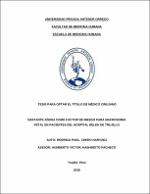| dc.contributor.advisor | Hashimoto Pacheco, Humberto Victor | |
| dc.contributor.author | Chero Narvaez, Rodrigo Paúl | |
| dc.creator | Chero Narvaez, Rodrigo Paúl | |
| dc.date.accessioned | 2018-09-10T15:06:55Z | |
| dc.date.available | 2018-09-10T15:06:55Z | |
| dc.date.issued | 2018 | |
| dc.identifier.uri | https://hdl.handle.net/20.500.12759/4293 | |
| dc.description.abstract | Objetivo: Determinar si el ser gestante añosa es factor de riesgo para
macrosomía fetal en pacientes del Hospital Belen de Trujillo.
Material y Métodos: Se llevó a cabo un estudio de tipo analítico,
observacional, retrospectivo, de cohortes retrospectivas. La población de
estudio estuvo constituida por 124 gestantes; las cuales fueron divididas en
2 grupos: con condición de gestante añosa o sin ella; se calculó el riesgo
relativo y la prueba chi cuadrado.
Resultados: La frecuencia de macrosomía fetal en gestantes añosas fue
de 23%. La frecuencia de macrosomía fetal en gestantes entre 20 a 35 años
fue de 9%. El ser gestante añosa es factor de riesgo para macrosomía fetal
con un riesgo relativo de 2.3 el cual fue significativo (p<0.05). En el análisis
multivariado se verifica la significancia del riesgo solo para la variable
gestante añosa y edad gestacional postérmino y no para las demás
variables, en relación con la aparición del desenlace macrosomía fetal.
Conclusiones: El ser gestante añosa es factor de riesgo para macrosomía
fetal en pacientes del Hospital Belen de Trujillo. | es_PE |
| dc.description.abstract | Objective: To determine if being a pregnant woman is a risk factor for fetal
macrosomia in patients of Belen Hospital in Trujillo.
Material and Methods: An analytical, observational, retrospective,
retrospective cohort study was carried out. The study population consisted
of 124 pregnant women; which were divided into 2 groups: with pregnant or
elderly status; the relative risk and the chi square test were calculated.
Results: The frequency of fetal macrosomia in elderly pregnant women was
23%. The frequency of fetal macrosomia in pregnant women between 20 to
35 years was 9%. Being a pregnant woman is a risk factor for fetal
macrosomia with a relative risk of 2.3 which was significant (p <0.05). In the
multivariate analysis, the significance of the risk is verified only for the
pregnant variable aged and gestational age post-term and not for the other
variables, in relation to the appearance of the outcome fetal macrosomia.
Conclusions: Being a pregnant woman is a risk factor for fetal macrosomia
in patients of Belen Hospital in Trujillo. | en_US |
| dc.description.uri | Tesis | es_PE |
| dc.format | application/pdf | es_PE |
| dc.language.iso | spa | es_PE |
| dc.publisher | Universidad Privada Antenor Orrego | es_PE |
| dc.relation.ispartofseries | T_MED.HUMA_2425 | |
| dc.rights | info:eu-repo/semantics/openAccess | es_PE |
| dc.rights.uri | https://creativecommons.org/licenses/by/4.0/ | es_PE |
| dc.source | Universidad Privada Antenor Orrego | es_PE |
| dc.source | Repositorio Institucional - UPAO | es_PE |
| dc.subject | Gestante añosa | es_PE |
| dc.subject | Macrosomía fetal | es_PE |
| dc.title | Gestante añosa como factor de riesgo para macrosomía fetal en pacientes del Hospital Belén de Trujillo | es_PE |
| dc.type | info:eu-repo/semantics/bachelorThesis | es_PE |
| thesis.degree.level | Título Profesional | es_PE |
| thesis.degree.grantor | Universidad Privada Antenor Orrego. Facultad de Medicina Humana | es_PE |
| thesis.degree.name | Médico Cirujano | es_PE |
| thesis.degree.discipline | Medicina Humana | es_PE |
| dc.subject.ocde | https://purl.org/pe-repo/ocde/ford#3.02.27 | es_PE |
| renati.type | https://purl.org/pe-repo/renati/type#tesis | es_PE |
| renati.level | https://purl.org/pe-repo/renati/level#tituloProfesional | es_PE |
| renati.discipline | 912016 | es_PE |
| dc.publisher.country | PE | es_PE |


